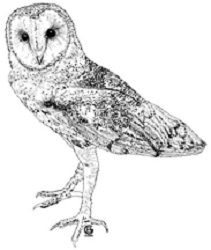
Scientific Name: Tyto alba
This is a medium sized owl with a distinctive, large head with a white, heart-shaped face and small dark eyes; legs are long, wings are broad but fairly pointed. Plumage is pale tawny in both sexes, with the male having pale to white undersides of body and wings. Females are slightly larger in body size, as with most other raptors, and may be darker. Flight is silent, swift, and buoyant. The relatively small eyes and the sound-gathering feathered facial disc of the Barn Owl indicate its ability to hunt by sound only, throughout the darkest hours of the night or for prey in tall grass.
Male
Length: 17″ ave.
Wingspan: 45″ ave.
Weight: 15.6 oz. ave.
Female
Length: 17″ ave.
Wingspan: 45″ ave.
Weight: 17.3 oz. ave.
State and federally protected; listed as endangered in many mid-western and eastern states; declining in Great Britain.
Widespread, but not common, in areas with lots of open fields, marshes, and pasture for hunting and large hollow trees or numerous old buildings for breeding sites. Less common in open countryside that has been intensely cultivated.
Diet – Hunts by extended solitary flights over open ground, often following favorite routes. Eats any small mammals to be found at dusk and into the night in open habitats – primarily voles, shrews, mice and other rodents. Average prey size is generally smaller than that of great horned owls that may inhabit the same area. In places where the larger great horned owls are present, barn owls may hunt only in hours of darkness, not only to avoid competing for food with the larger, more crepuscular owl species, but to avoid falling prey to them as well.
This nocturnal species uses a great variety of calls, from screaming, screeching, hissing, purring notes, to a repeating wheezy hiss called “snoring.” The most common call is a hissing shriek: cssssshhH.
Originally nested in caves, cliff faces, and hollow trees, but take advantage of barns, attics, and other man-made structures where these are available.
These owls are often hit by cars or trucks when flying low across or along roads at night. Nests built in places where human disturbance is likely, such as haystacks, buildings, and other structures, are often destroyed; young often fall from nests or fledge from nests into dangerous areas, such as manufacturing plants, warehouses, mills.

One of the most widespread of all birds, the Barn Owl is resident throughout North America except in the northern Rockies and northern Great Plains, and extending south down to the tip of South America. Other races of Barn Owls occur throughout the world.
Special Thanks for range maps:
Dan Gleason
BGleason Design & Illustration
Commercial & Scientific Illustration, Graphic Design
CraneDance Communications
Book Production/Design

